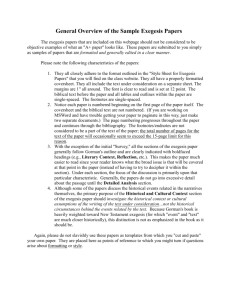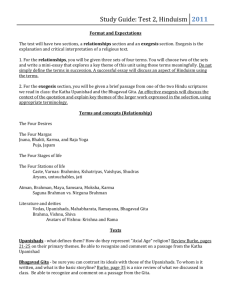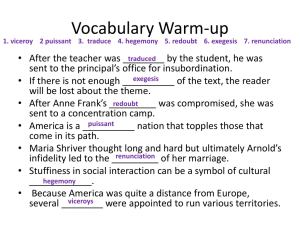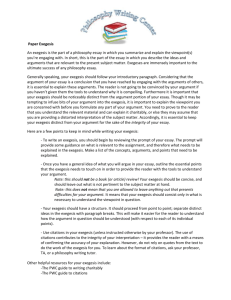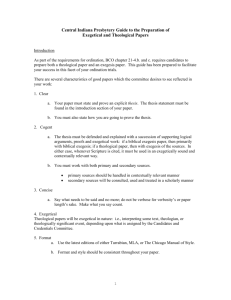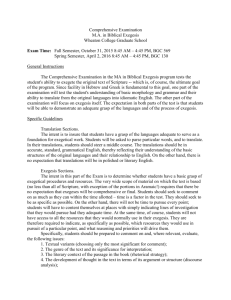Lesson 6 - 30044566
advertisement
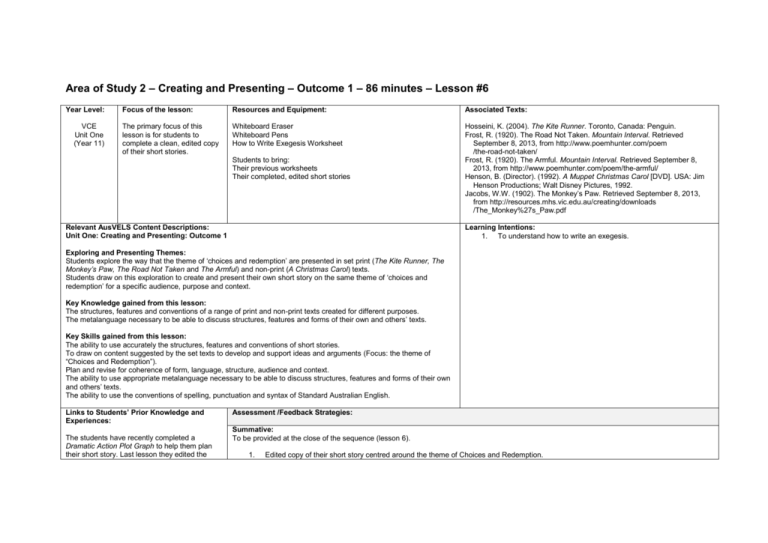
Area of Study 2 – Creating and Presenting – Outcome 1 – 86 minutes – Lesson #6 Year Level: VCE Unit One (Year 11) Focus of the lesson: Resources and Equipment: Associated Texts: The primary focus of this lesson is for students to complete a clean, edited copy of their short stories. Whiteboard Eraser Whiteboard Pens How to Write Exegesis Worksheet Hosseini, K. (2004). The Kite Runner. Toronto, Canada: Penguin. Frost, R. (1920). The Road Not Taken. Mountain Interval. Retrieved September 8, 2013, from http://www.poemhunter.com/poem /the-road-not-taken/ Frost, R. (1920). The Armful. Mountain Interval. Retrieved September 8, 2013, from http://www.poemhunter.com/poem/the-armful/ Henson, B. (Director). (1992). A Muppet Christmas Carol [DVD]. USA: Jim Henson Productions; Walt Disney Pictures, 1992. Jacobs, W.W. (1902). The Monkey’s Paw. Retrieved September 8, 2013, from http://resources.mhs.vic.edu.au/creating/downloads /The_Monkey%27s_Paw.pdf Students to bring: Their previous worksheets Their completed, edited short stories Relevant AusVELS Content Descriptions: Unit One: Creating and Presenting: Outcome 1 Learning Intentions: 1. To understand how to write an exegesis. Exploring and Presenting Themes: Students explore the way that the theme of ‘choices and redemption’ are presented in set print (The Kite Runner, The Monkey’s Paw, The Road Not Taken and The Armful) and non-print (A Christmas Carol) texts. Students draw on this exploration to create and present their own short story on the same theme of ‘choices and redemption’ for a specific audience, purpose and context. Key Knowledge gained from this lesson: The structures, features and conventions of a range of print and non-print texts created for different purposes. The metalanguage necessary to be able to discuss structures, features and forms of their own and others’ texts. Key Skills gained from this lesson: The ability to use accurately the structures, features and conventions of short stories. To draw on content suggested by the set texts to develop and support ideas and arguments (Focus: the theme of “Choices and Redemption”). Plan and revise for coherence of form, language, structure, audience and context. The ability to use appropriate metalanguage necessary to be able to discuss structures, features and forms of their own and others’ texts. The ability to use the conventions of spelling, punctuation and syntax of Standard Australian English. Links to Students’ Prior Knowledge and Experiences: The students have recently completed a Dramatic Action Plot Graph to help them plan their short story. Last lesson they edited the Assessment /Feedback Strategies: Summative: To be provided at the close of the sequence (lesson 6). 1. Edited copy of their short story centred around the theme of Choices and Redemption. story. 2. 3. Finalised copy of their short story centred around the theme of Choices and Redemption. A written exegesis explaining their short story as well as its audience, purpose and context. Lesson Sequence What will I do? What will students do? Orient Welcome students. Write the learning intentions on the whiteboard Discuss the learning intention with the students. Explain the Agenda: 1. Students will be finalising their stories (creating a clean, edited copy). 2. Once this is completed, students are to write their exegesis. Students to come in and sit down quietly. Engage Students are to produce their short story clean copy. Students are to complete their final clean copy of their short story having taken into consideration any editorial changes that they have made. Transform and Extend Explain what an exegesis is. The students have done this before. Hand out running sheet: How to Write an Exegesis. Read through the worksheet as a group. Students will be randomly chosen to read each section of the sheet out loud. Any questions should be asked throughout this discussion. Quick Brainstorm: 1. Why might an exegesis be helpful to authors post writing? Students should assist in adding any ideas to the whiteboard brainstorm. Students are to write their exegesis using the running sheet. Reflect and Evaluate Discussion Key Questions 1. Was it hard writing an exegesis? 2. Did it make you think critically about what you have learned and what you have written? 3. Did the pre-planning worksheets help you to write your exegesis? How? 4. What are the benefits of writing an exegesis? The facilitator should add any new information to the brainstorm and discuss how views have progressed over the course of the class. Students are to participate in the discussion, think critically about how writing an exegesis can assist them to develop their writing. Students are to hand in the following at the close of class for assessment: 1. Edited copy of their short story centred around the theme of Choices and Redemption. 2. Finalised copy of their short story centred around the theme of Choices and Redemption. 3. A written exegesis explaining their short story as well as its audience, purpose and context. Observations and notes for next lesson:
